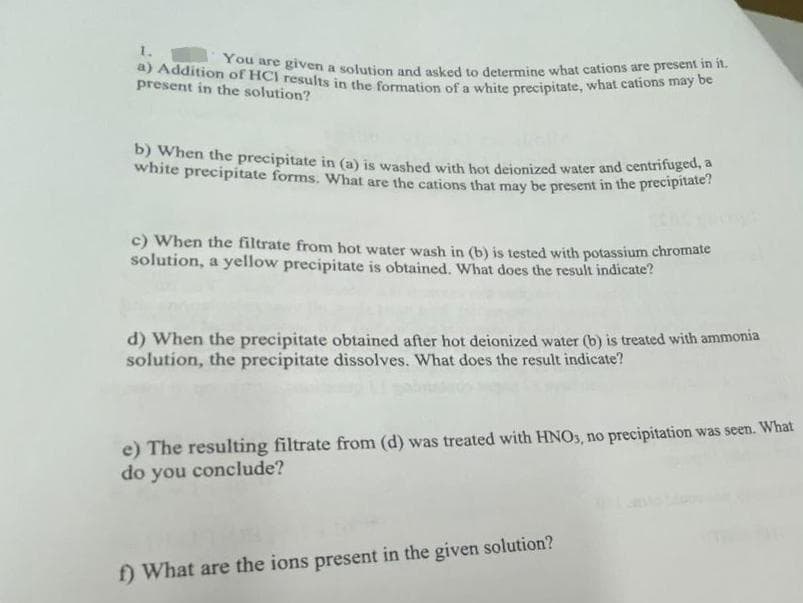white precipitate forms. What are the cations that may be present in the precipitate? a) Addition of HCI results in the formation of a white precipitate, what cations may be 1. ou are given a solution and asked to determine what cations are present in n. present in the solution? b) When the precipitate in (a) is washed with bot deionized water and centrifuged, a c) When the filtrate from hot water wash in (b) is tested with potassium chromate solution, a yellow precipitate is obtained. What does the result indicate? d) When the precipitate obtained after hot deionized water (b) is treated with ammonia solution, the precipitate dissolves. What does the result indicate? e) The resulting filtrate from (d) was treated with HNOS, no precipitation was seen. What do you conclude? ) What are the ions present in the given solution?
white precipitate forms. What are the cations that may be present in the precipitate? a) Addition of HCI results in the formation of a white precipitate, what cations may be 1. ou are given a solution and asked to determine what cations are present in n. present in the solution? b) When the precipitate in (a) is washed with bot deionized water and centrifuged, a c) When the filtrate from hot water wash in (b) is tested with potassium chromate solution, a yellow precipitate is obtained. What does the result indicate? d) When the precipitate obtained after hot deionized water (b) is treated with ammonia solution, the precipitate dissolves. What does the result indicate? e) The resulting filtrate from (d) was treated with HNOS, no precipitation was seen. What do you conclude? ) What are the ions present in the given solution?
Principles of Modern Chemistry
8th Edition
ISBN:9781305079113
Author:David W. Oxtoby, H. Pat Gillis, Laurie J. Butler
Publisher:David W. Oxtoby, H. Pat Gillis, Laurie J. Butler
Chapter15: Acid–base Equilibria
Section: Chapter Questions
Problem 97AP
Related questions
Question
please answer all subparts its one question

Transcribed Image Text:white precipitate forms. What are the cations that may be present in the precipitate?
a) Addition of HCl results in the formation of a white precipitate, what cations may be
You are given a solution and asked to determine what cations are present in it.
1.
present in the solution?
B) When the precipitate in (a) is washed with hot deionized water and centrifuged,
c) When the filtrate from hot water wash in (b) is tested with potassium chromate
solution, a yellow precipitate is obtained. What does the result indicate?
d) When the precipitate obtained after hot deionized water (b) is treated with ammonia
solution, the precipitate dissolves. What does the result indicate?
e) The resulting filtrate from (d) was treated with HNOS, no precipitation was seen. What
do you conclude?
f) What are the ions present in the given solution?
Expert Solution
This question has been solved!
Explore an expertly crafted, step-by-step solution for a thorough understanding of key concepts.
Step by step
Solved in 6 steps

Knowledge Booster
Learn more about
Need a deep-dive on the concept behind this application? Look no further. Learn more about this topic, chemistry and related others by exploring similar questions and additional content below.Recommended textbooks for you

Principles of Modern Chemistry
Chemistry
ISBN:
9781305079113
Author:
David W. Oxtoby, H. Pat Gillis, Laurie J. Butler
Publisher:
Cengage Learning


Chemistry: Principles and Reactions
Chemistry
ISBN:
9781305079373
Author:
William L. Masterton, Cecile N. Hurley
Publisher:
Cengage Learning

Principles of Modern Chemistry
Chemistry
ISBN:
9781305079113
Author:
David W. Oxtoby, H. Pat Gillis, Laurie J. Butler
Publisher:
Cengage Learning


Chemistry: Principles and Reactions
Chemistry
ISBN:
9781305079373
Author:
William L. Masterton, Cecile N. Hurley
Publisher:
Cengage Learning


Chemistry
Chemistry
ISBN:
9781305957404
Author:
Steven S. Zumdahl, Susan A. Zumdahl, Donald J. DeCoste
Publisher:
Cengage Learning

Chemistry: An Atoms First Approach
Chemistry
ISBN:
9781305079243
Author:
Steven S. Zumdahl, Susan A. Zumdahl
Publisher:
Cengage Learning